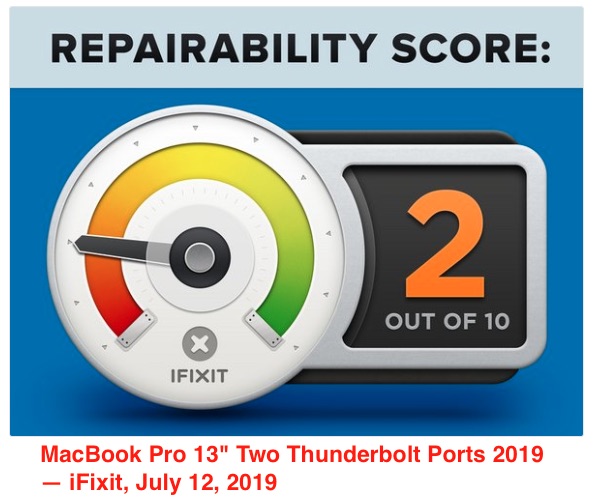; Date: Fri Jul 12 2019
Tags: Apple »»»»
Apple recently released updates to the MacBook Pro, and as expected repairability took a back seat. The team at iFixit did a teardown and found a bunch of repairability problems, awarding the machine with a 2 out of 10 repairability score. Yes it's possible to take the machine apart, but most of the parts are soldered on and basically non-replaceable except by uber-experts.

The specs of the MacBook Pro 2019 that
iFixit disassembled are:
- 13.3” LED-backlit IPS “Retina” display with 2560 × 1600 resolution (227 dpi), P3 color gamut
- 1.4 GHz quad-core Intel Core i5 (Turbo Boost up to 3.9 GHz) with integrated Intel Iris Plus Graphics 645
- 8 GB of 2133 MHz LPDDR3 onboard memory
- 128 GB, 256 GB, 512 GB, 1 TB, or 2 TB PCIe-based SSD
- Two Thunderbolt 3 (USB-C) ports supporting charging, DisplayPort, Thunderbolt, USB 3.1 Gen 2
- Apple T2 custom coprocessor
They also note it has model number A2159, and EMC 3301. A2159 is one of the newly registered model numbers noticed last month which caused some speculation about ARM-based MacBook models coming soon. It is likely the several new models Apple announced recently account for some or all of those new model numbers, and that the rumors of ARM based laptops are just wild speculation.
In any case what I wanted to focus on is the repairability of this machine.
- The case is held together with Pentalobe screws - requiring folks to get a special purpose screwdriver
- At least the trackpad, the headphone assembly and the speakers are easily replaceable
- Memory is soldered to the logic board
- SSD main storage is soldered to the logic board
- Keyboard is the same Butterfly design that everyone is up in arms over -- even more so, this laptop was immediately added to the "Keyboard Service Program" indicating that Apple does recognize that keyboard design has problems
In MacBook Pro's since 2013 the memory was not user replaceable nor upgradeable. Clearly this was done to make the machines slimmer, because a SODIMM holder requires a certain thickness. But still it is an egregious crime against repairability.
As for the SSD, I don't know when this started but recent MacBook Pro models used a proprietary SSD that was not user upgradeable even though it could easily be removed. Starting with this model the SSD is directly soldered to the logic board and is therefore not replaceable except by the sort of hardware repair wizards that have those skills. It is an egregious crime against repairability to solder the SSD in place.
This crime is stronger because it is an SSD and we know that SSD's have a tendency to wear out in a very different way from a spinning hard drive. What if after three years the SSD wears out, and as a nonreplaceable part it makes the laptop worthless? $2000 or whatever down the drain after three years just because Apple couldn't get their heads around repairability?
It is quite commonplace to use M.2 form factor SSD's in laptops nowadays. Those are easily replaceable and upgradeable. Doing either gives the customer all the power they need.
UPDATE: Turns out there is a simple adapter for installing standard NVMe SSD's into MacBook models with non-soldered SSD's. Obviously this does not help anyone buying the MacBook Pro described on this page, because a soldered SSD requires supreme wizardry to replace. This is one more reason to avoid the newest MacBook models, and to go with ones where parts can be replaced. See How to upgrade MacBook Air/Pro SSD to NVMe using this one weird SSD adapter
What Apple is doing removes power from the customer. It is egregious.











